Digital Exhibition
Kristen Clevenson
Something New In The Arts: Paula Cooper and the Careers of Lynda Benglis, Jackie Winsor, Jennifer Bartlett, and Elizabeth Murray
Kristen Clevenson
May 31, 2022
In 1968 Paula Cooper established her gallery south of Houston Street, in a neighborhood fast becoming a destination for contemporary art, indeed, one that arguably defined the very idea of “contemporary” versus modern. At that point, the designation ‘SoHo’ was barely five years old, and it was there, in the heart of this fledgling community of art and commerce, that Cooper launched the careers of artists Lynda Benglis, Jackie Winsor, Jennifer Bartlett, and Elizabeth Murray.
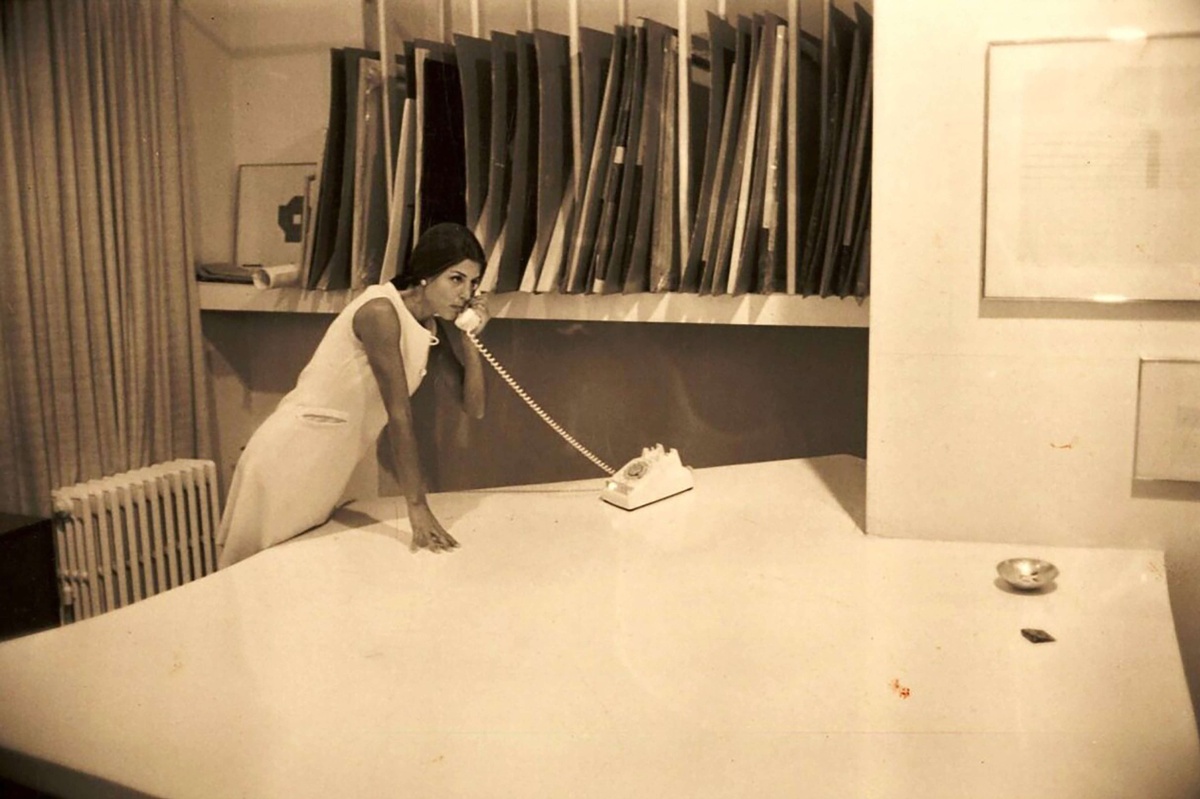
Photo: Peter Moore. Park Place, The Gallery of Art Research, Inc. records and Paula Cooper Gallery records, 1961-2006. Archives of American Art, Smithsonian Institution. Copyright held by Northwestern University.
Paula Cooper (née Johnson, b. 1938, Massachusetts) arrived in New York in 1959. She worked at World House Galleries on the Upper East Side then opened the Paula Johnson Gallery from her own home at 109 East 69th Street. There, she showed conceptual artist Walter de Maria, African American figurative painter Bob Thompson, and abstract landscape painters Robert Levine and Vernon Lobb, among others.
In 1965, Cooper joined Park Place, a cooperative gallery comprised of predominantly West Coast artists including Mark di Suvero, Forrest Myers, Tamara Melcher, Leo Valledor, Dean Fleming, and Peter Forakis, along with British artist Anthony Magar, and Americans Edwin Ruda and Robert Grosvenor. The gallery took its name from 79 Park Place, where it opened in 1962, before moving to a ground floor space just north of Houston Street at 542 West Broadway (now La Guardia Place).i In addition to mounting art exhibitions that showcased works by member and non-member artists alike, the Park Place gallery also hosted performances and events. Cooper described Park Place as the most “open situation […] They probably showed work by more different artists than any other place.”ii
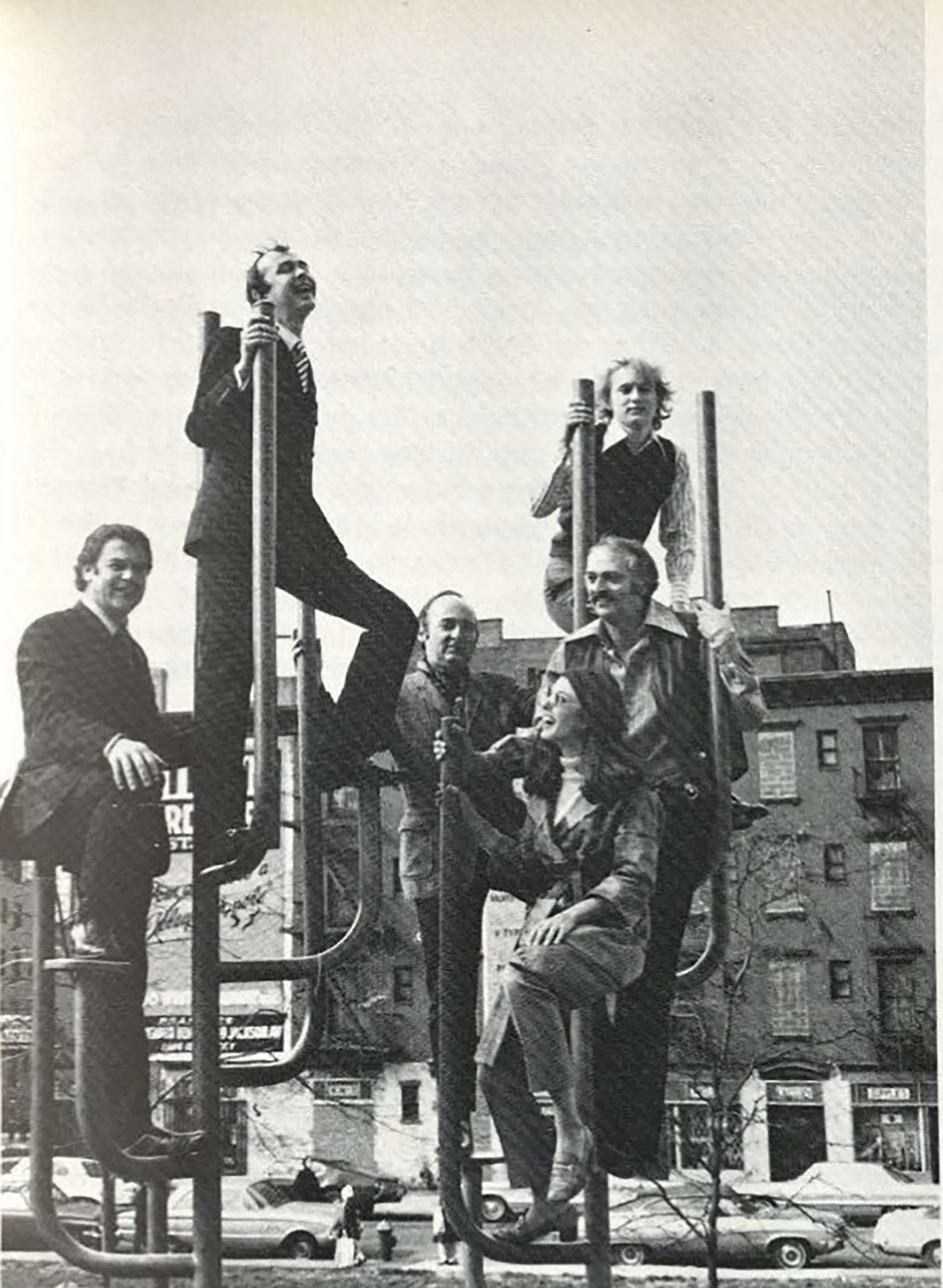
Photo: Jay Jacobs. Published in The Art Gallery Magazine XIII, no. 3 (December 1969): cover and p. 9.
In 1968, Cooper established her eponymous gallery at 96 Prince Street, in what was then the cultural hinterland south of Houston Street. Hers was one of two commercial galleries in the area, the other being Feigen Downtown, owned by Richard Feigen and run by Michael Findlay. Cooper quickly built her gallery’s reputation with two group exhibitions in collaboration with young and forward-thinking critics, notably Lucy Lippard. The gallery’s inaugural show: Benefit for the Student Mobilization Committee to End the War in Vietnam (October 22–31, 1968), featured artists associated with so-called Minimalism—Donald Judd, Carl Andre, and Sol LeWitt.
While many SoHo chroniclers have emphasized this exhibition in the Paula Cooper Gallery’s origin story, my research instead argues that she made her main mark—of lasting importance—in the subsequent decade. In the 1970s, Cooper devoted her energies to her stable of emerging artists whose artwork and methods could not be reduced to a single “ism” or trend, in a prescient take on the freedom of creative possibilities that defined the post-“ism,” post-modern era. These artists included Jennifer Bartlett, Lynda Benglis, Jonathan Borofsky, Robert Grosvenor, Elizabeth Murray, Joel Shapiro, Alan Shields, Richard Van Buren, Jackie Winsor, and Kes Zapkus.
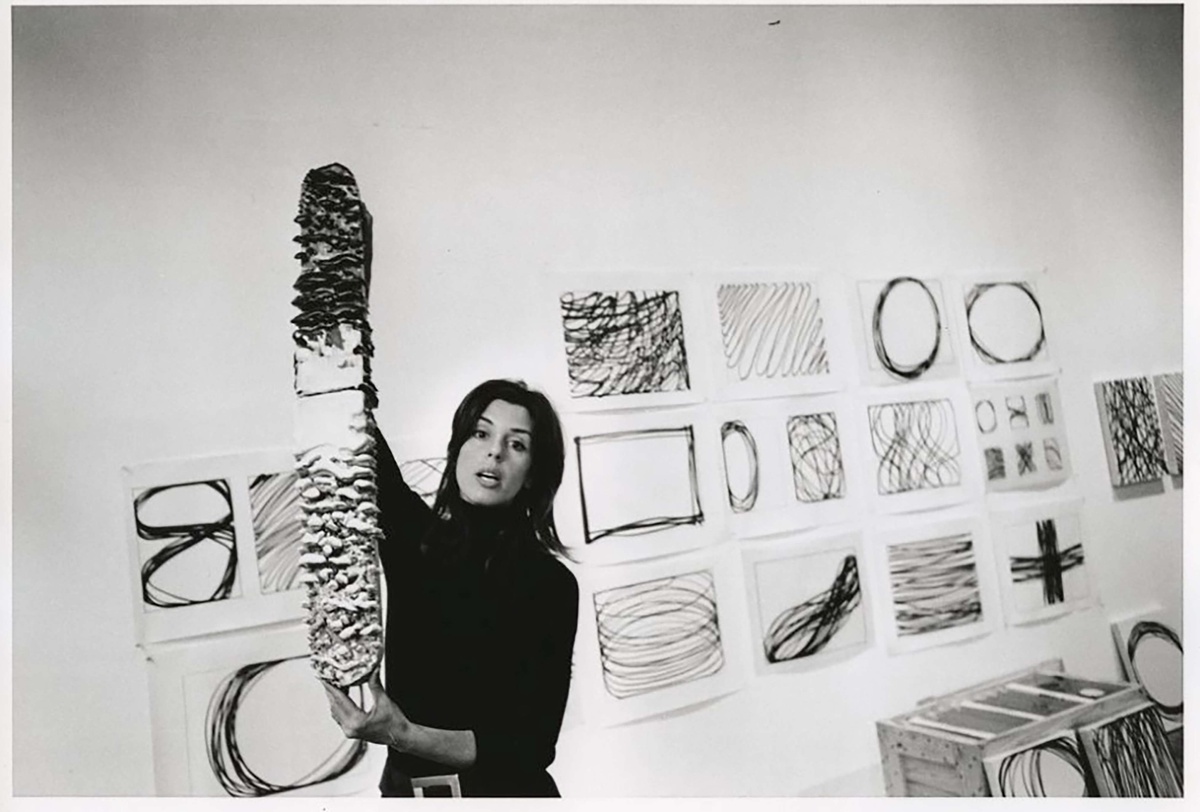
Photo: Duane Michals. Courtesy of Paula Cooper Gallery.
One of Cooper’s most important and least remarked upon contributions was her support for women artists in the heyday of the second-wave feminist movement. Though Cooper was not an activist and is not considered a “feminist” art dealer, the number of women she represented and the prominence she gave them in her gallery was, for the time, historic and consequential.
Between 1969 and 1979—a decade in which feminism advanced in public awareness and changed the making and interpretation of art—Cooper built the careers of Lynda Benglis, Jennifer Bartlett, Elizabeth Murray, and Jackie Winsor. Working in tandem with their respective pace of production, she gave them regular solo exhibitions while also placing key works in thematic group shows. Cooper ensured that their works entered museum institutions, were bought and appreciated by private collectors (of varied economic means), and determined that reviews of their exhibitions would compete favorably with the coverage received by their male peers. Today, each of these artists has a secure place in the histories of late-twentieth-century art for their innovative materials and processes, signature imagery, contributions to post-minimalism, and resurgent figurative idioms.
Lynda Benglis
“People liked her, and still do love her. She has the type of personality that’s firm, and she knows what she wants, and she doesn’t hesitate when she likes something. She commits to it. I found that true. I showed with her and got started with her, and I found that true of her since I’ve known her.”
Lynda Benglis speaking about Paula Cooper, 2018iii
Paula Cooper met Lynda Benglis (b. 1941, Lake Charles, Louisiana) at the Paula Johnson Gallery on the Upper East Side in the early 1960s. About five years later, she became one of the first artists that the Paula Cooper Gallery officially represented. In the early years, Benglis worked part-time at the gallery; she “needed money to be able to live and make her art,” Cooper recalled. “It was quite an experience having her come in. Even typing a letter turned into a comic event of some sort. She had her mind completely on her art.”iv
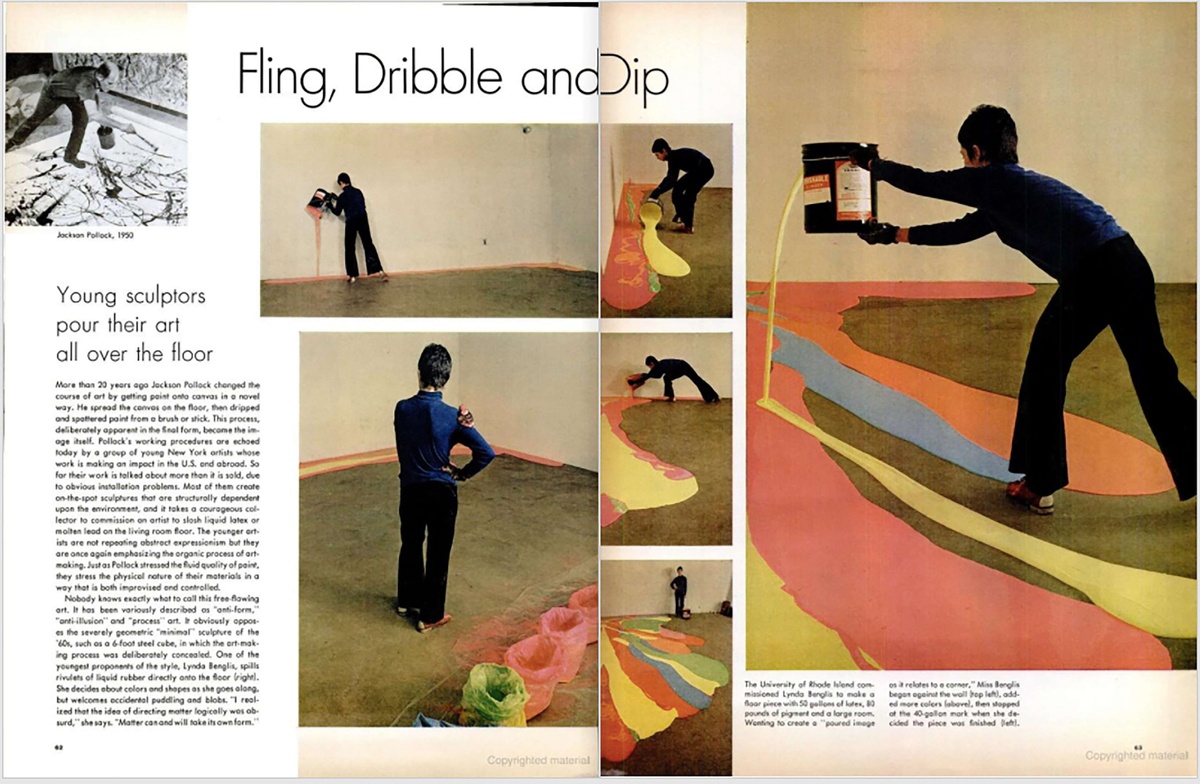
In 1969, Cooper included Benglis’s multicolored poured floor painting or ‘mat,’ Contraband (1969), in a three-person exhibition: Lynda Benglis, Gary Dubosen, Alan Shields (September 20–October 15). Soon after, the Whitney Museum included her in the 1969 Annual Exhibition (the annual iteration of what became the Whitney biennial; held December 16, 1969–February 1, 1970).
Cooper immediately followed the Whitney exhibition with Benglis’s first New York solo exhibition: Lynda Benglis (February 8–March 4, 1970), which focused on the artist’s sculptural poured pieces. Jean-Louis Bourgeois’s positive review for Artforum used explicitly gendered terms to describe the works: “Painterly and rich, they seemed the resurrection of extraordinary craft by a slower, gentler sensibility, an event to enjoy and herald.”v

Courtesy of Paula Cooper Gallery.
Under Cooper’s aegis, such new “anti-form” sensibilities, gentle or not, became an asset. LIFE magazine published photographs of Benglis in her studio, pouring neon-colored liquid from large buckets in the article “Fling, Dribble, and Drip,” in an obvious allusion to the photo essay on Jackson Pollock in the same magazine, some 20 years earlier. The point was not only that a woman was now flinging the paint: it threw the spotlight on Benglis as one of the leaders of a new artistic movement that focused on process and formless material, a pivot from the geometric and industrially manufactured forms of 1960s Minimalist artists.
Jackie Winsor
“Paula Cooper is my dealer, and she’s been very supportive. When I originally started showing in the early ’70s, it was at the beginning of the women’s movement. She is very supportive of women artists.”
Jackie Winsor on Paula Cooper, 1979vi
Vera Jacqueline Winsor (b. 1941, Newfoundland, Canada), personally and professionally known as Jackie Winsor, moved to New York in 1967. She met Cooper at a conference in Washington, D.C., organized in conjunction with the women’s movement. Winsor was attracted to the dealer’s commitment to exhibiting sculpture and understanding of the space, marketing, and material considerations the medium required. As was typical, before representing Winsor exclusively, Cooper included her in a group exhibition (June 6–23, 1972), which featured both gallery artists and invited artists. Winsor was represented by Bound Square (1972), comprised of four logs bound together with copious amounts of wrapped twine at each corner.

Artworks pictured include Bound Square (1972), Plywood Square (1973, foreground), Double Bound Circle (1971), Chunk Piece (1970), Nail Piece (1970), Bound Logs (1972–1973), Four Corners (1972), Double Circle (1970), and Laminated Plywood (1973).
Courtesy of Paula Cooper Gallery.
When the Paula Cooper Gallery moved from Prince Street to 155 Wooster Street in 1973, Winsor enjoyed one of the first solo shows in the space (October 20–November 14). Along with Bound Square, Cooper presented nine other sculptures made by wrapping twine around solid forms or manipulating, nailing, and gouging plywood. James Mellow’s favorable review in the New York Times read, “What makes this work more enterprising than that of many sculptors of similar persuasion, is that Miss Winsor does not stop short with the oddness of the materials, but draws upon their qualities of color and texture to very good effect.”vii
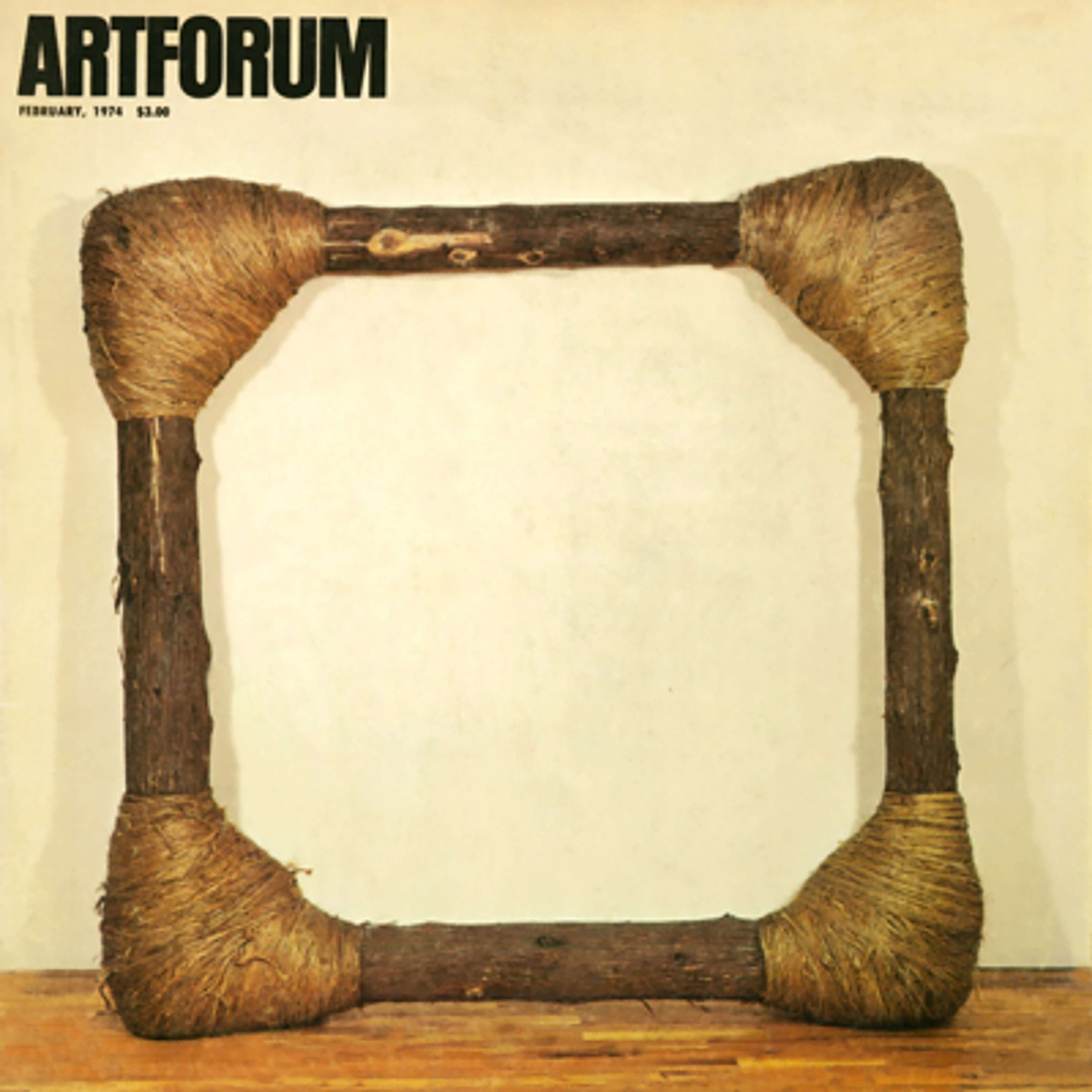
Bound Square was reproduced as the cover of the February 1974 issue of Artforum, which contained a feature article on Winsor by Lippard, an early supporter of the artist and friend of Cooper.viii Moreover, Cooper went on to place nearly every one of Winsor’s pieces from the show in prominent museum collections. That the works were so quickly praised and placed in museums is an early indication of the dealer’s eye and imprimatur.
In 1979, MoMA presented the mid-career survey Jackie Winsor, curated by Kynaston McShine. It was the first exhibition of a female artist organized by MoMA’s Department of Painting and Sculpture since 1946 and one of only thirty solo exhibitions of women artists since the museum opened in 1929.ix
Jennifer Bartlett
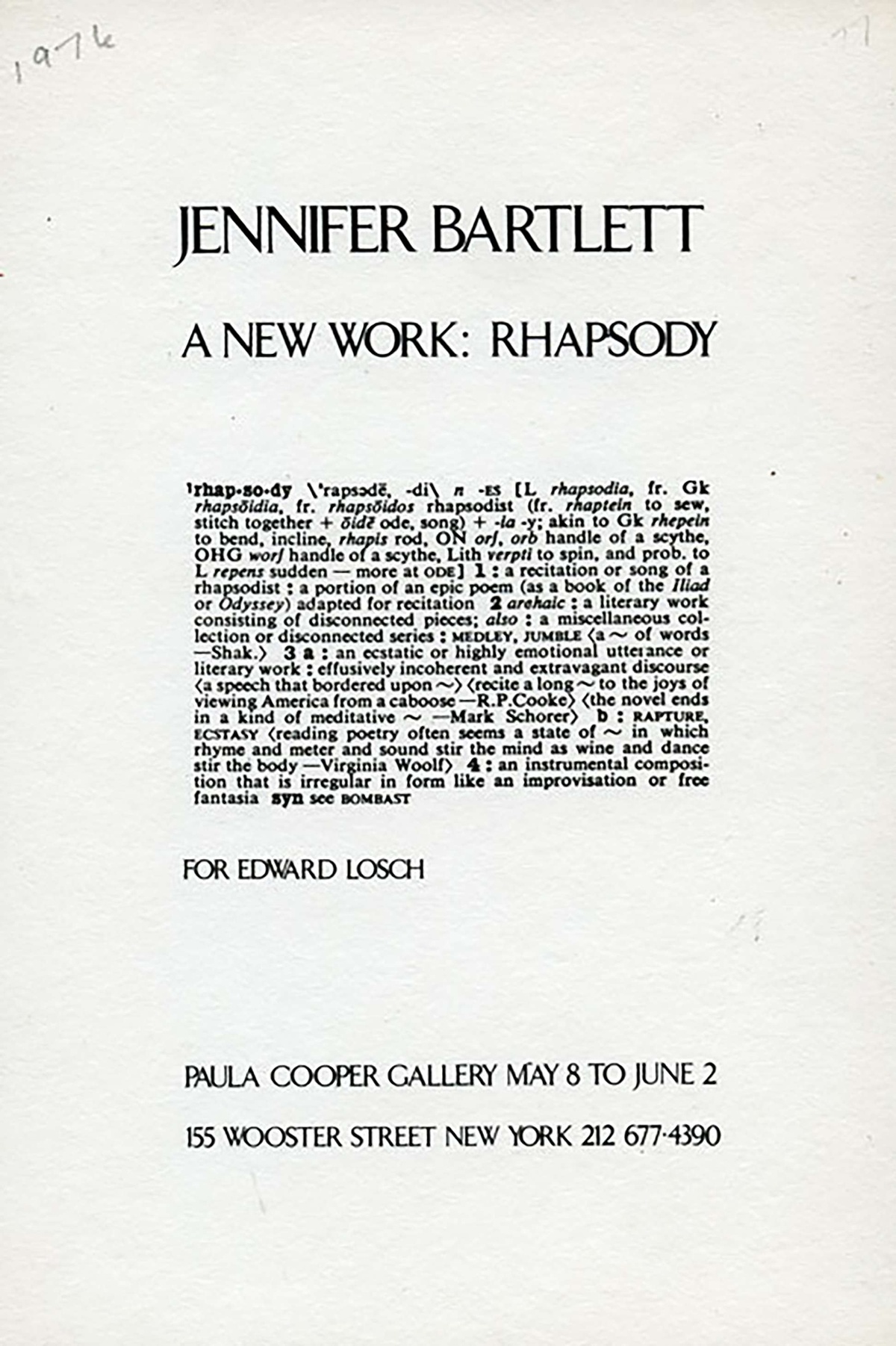
Courtesy of Paula Cooper Gallery.
Jennifer Bartlett (b.1941, Long Beach, California—d.2022, Amagansett, New York) came to New York in 1968 and settled in SoHo, where she was a neighbor of Joel Shapiro, an artist friend from Yale who Cooper soon represented. Bartlett had two early solo shows in SoHo: one of which was an informal installation at Alan Saret’s loft at 119 Spring Street in 1970, for which the Paula Cooper Gallery offered its mailing list. Barlett visited the Paula Cooper Gallery in 1971 to view sculptures by Shapiro. Cooper recalled, “I thought she was very sophisticated, with her makeup on crooked and her philosophical pronouncements about Joel’s work.”x
After including Bartlett in a poetry and fiction reading and her painted steel plate paintings in several group exhibitions, Cooper mounted her first solo exhibition at the gallery from March 6–30, 1974.
“I thought she was very sophisticated, with her makeup on crooked and her philosophical pronouncements about Joel’s work.”
Paula Cooper on Jennifer Bartlett, 1984
Jennifer Bartlett, A New Work: Rhapsody, Bartlett’s second solo exhibition at the Paula Cooper Gallery, ran from May 8–June 2, 1976. This exhibition showed one monumental work: a painting composed of nearly 1,000 one-foot-square steel plates, each of which Bartlett painted with patterns, geometric forms, or figurative images. The painting perfectly filled the walls of the gallery. In the lead article in the New York Times Arts and Leisure section, John Russell raved that it was “The most ambitious single work of new art.”xi
Grace Glueck published a feature interview with the artist and critic Paul Brach reviewed the exhibition in Artforum. A new collector, Sidney Singer, called Cooper, came to the gallery, and bought the work in full (all 987 steel plates) shortly after the exhibition opened.
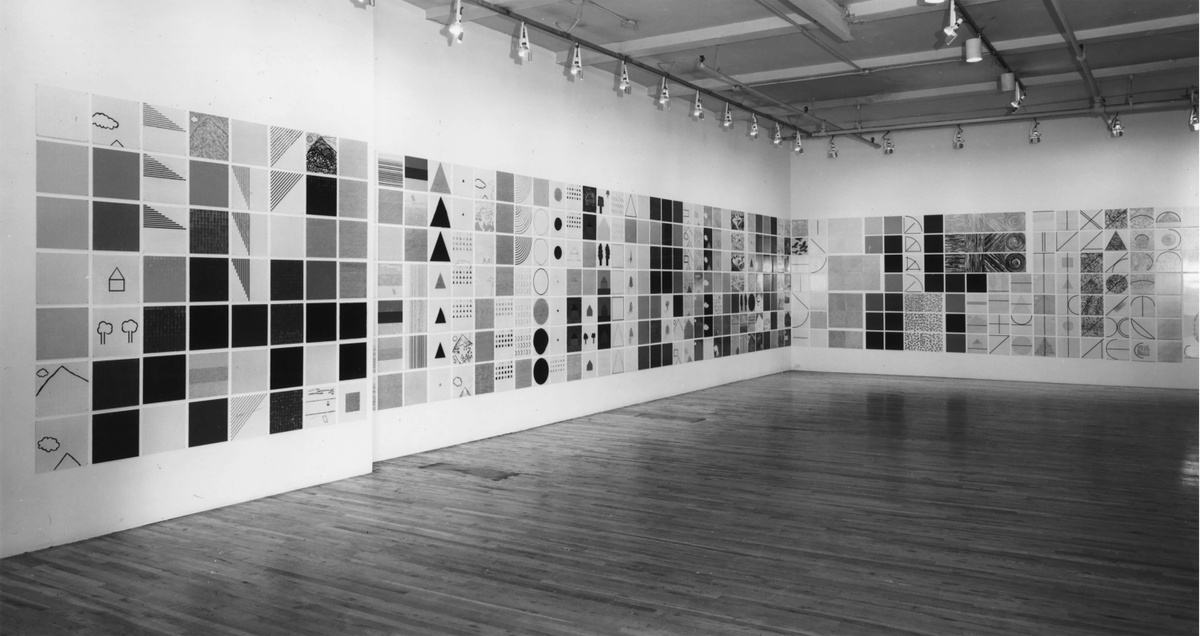
Courtesy of Paula Cooper Gallery.
As part of the deal, however, Cooper negotiated that the work be seen in public widely (a form of both advance marketing for work yet to be made and ensuring Bartlett’s reputation) before it entered the privacy of his home or warehouse: from 1976–79 Rhapsody was included in at least ten prominent museum exhibitions, generating continued publicity and increased viewing of Bartlett’s first major achievement. In 1977 the Whitney purchased, through Cooper, a twenty-foot-long, multipart painting: Falcon Avenue, Seaside Walk, Dwight Street, Jarvis Street, Greene Street (also from 1976).
Elizabeth Murray
“Paula had people’s respect, and having her behind my work was a strong part of it. People took her seriously, and if she was showing someone, they were going to take that artist seriously. I felt that Paula really liked my work and that was, very, very important for me. […] it was the first time I sensed that a dream could come true. My dream was to be able to make my work and to survive. And with support, I was starting to do that.”
Elizabeth Murray on Paula Cooper, 2005xii
Elizabeth Murray (b. 1940, Chicago, IL—d. 2007, Granville, NY) moved to New York in 1967 and much later recounted, “At first I felt quite out of it. Pop was so campy, and Minimalism—just beginning—was equally off-putting. The word being spread was, ‘Haven’t you heard? Painting is dead!’ I thought, ‘Oh, really? Well, to hell with that. I’m painting.’”xiii
In tandem with the burgeoning feminist movement, traditional approaches to solid supports, paint application, and even the wall were being jettisoned. Murray was on the forefront and experimented with shaped canvas and panel supports. It was not only Cooper’s reputation that drew Murray to her stable. In the early 1970s, Murray recalled, “Paula and I had a lot in common—at that time we were both single mothers.”xiv
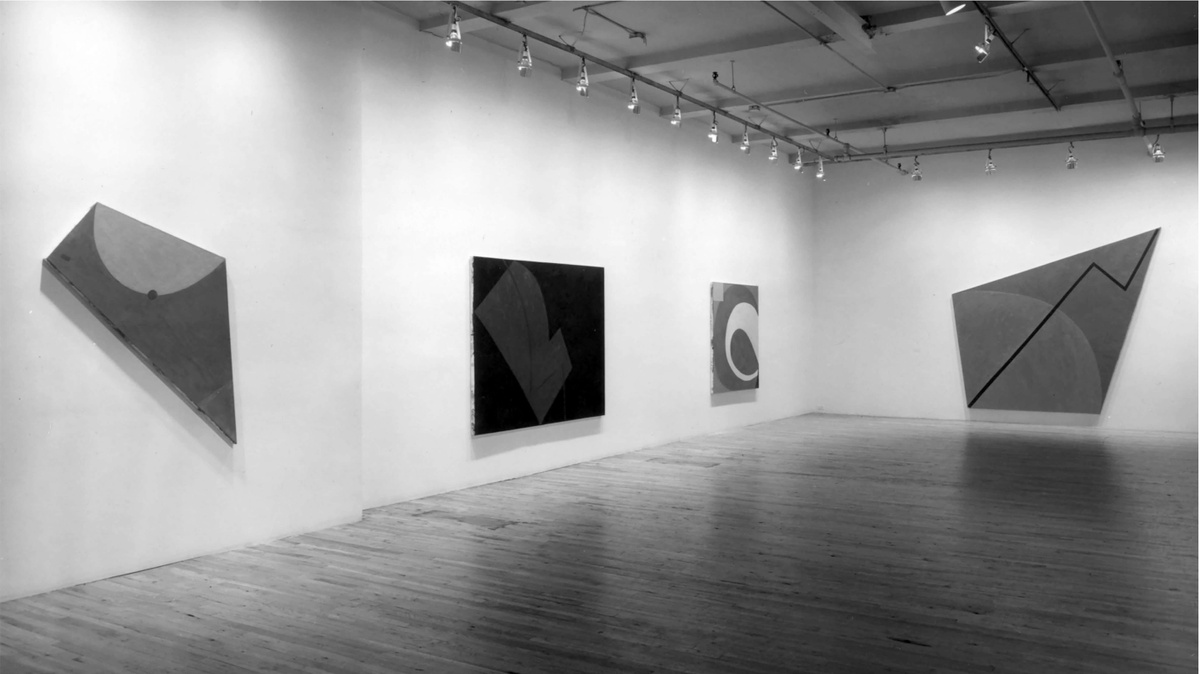
Courtesy of Paula Cooper Gallery.
As was typical, Cooper included Murray’s work in at least three different group exhibitions before presenting her solo. In November 1976, Elizabeth Murray: Paintings opened at the Cooper Gallery, followed by a second solo show held from October 7–November 4, 1978. New York Times critic John Russell wrote that Murray’s “paintings are worth puzzling over.”xv
Roberta Smith (no longer working at the Cooper gallery) observed, “The abundance of personality makes it look like Murray is working backward from abstraction toward representation, not in terms of imagery per se, but in terms of energy; some shapes seem ready to jump right off the canvas and strut away.”xvi
In February 1978, Murray’s painting filled the cover of Artforum which also included a richly illustrated feature article written by Donald B. Kuspit.xvii Cooper sold Murray’s painting, Children Meeting (1978), to the Whitney that same year. In 2003, Murray became the fifth female artist ever to have a retrospective exhibition at the Museum of Modern Art.xviii
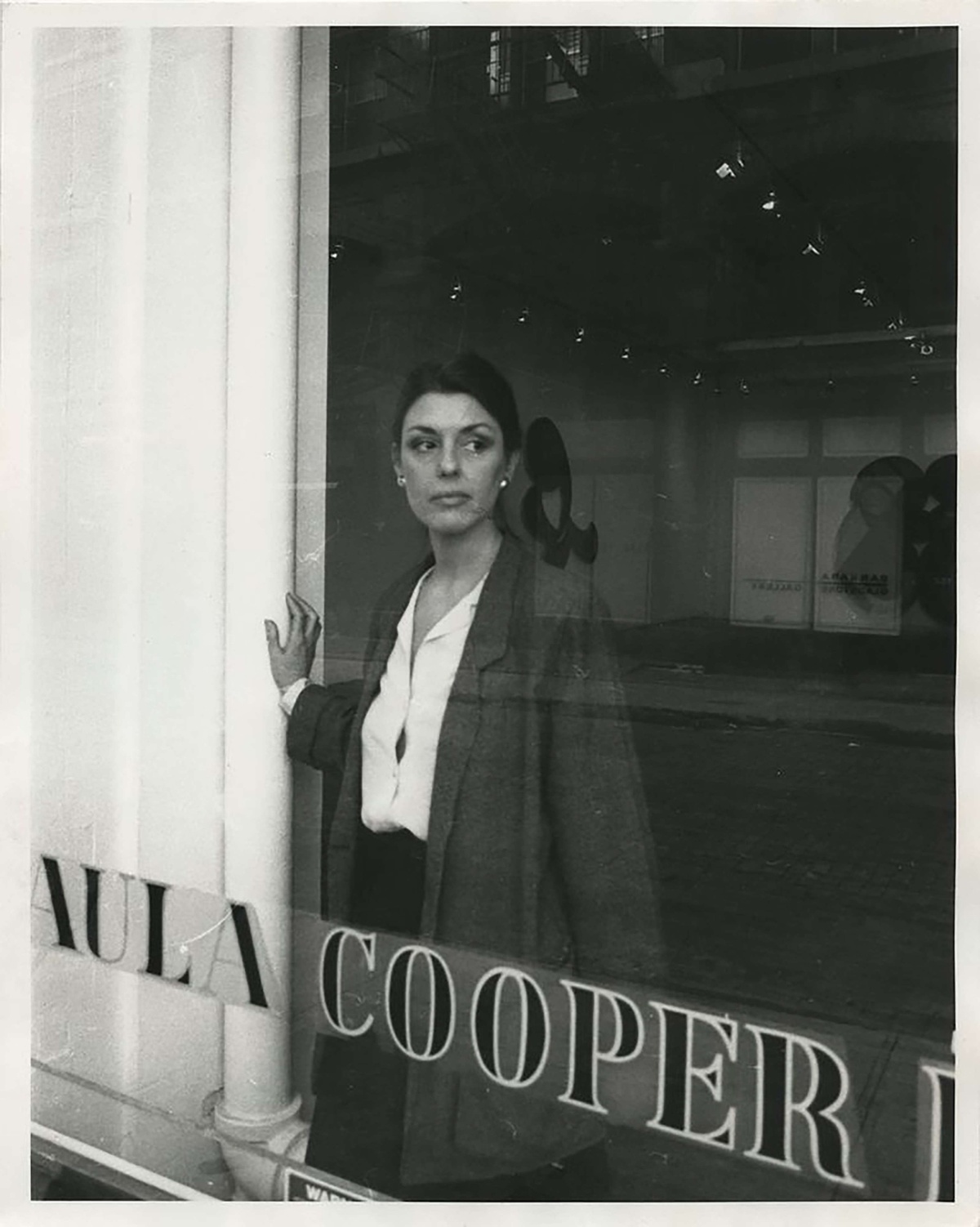
Photo: Leslie Schulman. Courtesy of Paula Cooper Gallery.
In the early 1970s, Cooper presented Benglis, Winsor, and Murray’s first New York and commercial gallery solo exhibitions and Bartlett’s second, which introduced their radical reinvention of traditional ideas of painting and sculpture to collectors, critics, curators, and other artists. That they also happen to be women artists, one might argue, was due to the “same and equal” attitude of their dealer, one who neither publicly promoted nor denied gender difference in the making or showing of art. Cooper did not programmatically refer to the four as “women” artists; nor did they categorize her as a “female” dealer, even if the issue of their sex was always a reality in the art world, and even as Cooper’s gallery hosted events associated with politics, including those devoted to the feminist movement. Though not self-identified as such, Cooper and her gallery stood for the advancement of women artists.
Kristen Clevenson is an MA candidate in Art History at Hunter College, The City University of New York, and the Curatorial Assistant for the Robert Rauschenberg Foundation, New York. Her research has been published by the Rauschenberg Foundation, Assemblage journal, and Thaddeus Ropac gallery. She has been involved in several curatorial projects, including Seeing Sound, an exhibition curated by Barbara London that is being circulated by Independent Curators International, Her Right to K(no)w at Hunter East Harlem Gallery (spring 2020), and The Lives of the Artists, an exhibition of Hunter MFA students at 205 Hudson Street (winter 2019). She curated this exhibition as a part of The Feminist Institute/Hunter College Archival Research Grant Program in Feminist Art History.
This text is part of Clevenson’s thesis “An Early and Feminist History of the Paula Cooper Gallery” (Hunter College, MA in Art History program). She would like to thank Paula Cooper and Distinguished Professor Emily Braun for their attention and feedback. Thanks also to Marie Williams Chant for her excellent design and support.
Citations are available at this link.
The full text of the exhibition is available at this link.
Image Credits
The portraits of Paula Cooper by Duane Michals and Richard Leslie Schulman and the installation images are courtesy of Paula Cooper Gallery. Many thanks to Paula Cooper and Daisy Charles, Director of Archives at Paula Cooper Gallery.
Peter Moore’s portrait of Paula Cooper is courtesy of Northwestern University, which holds the copyright to Peter Moore’s Archives. Many thanks to Scott Krafft, Curator at Charles Deering McCormick Library of Special Collections.